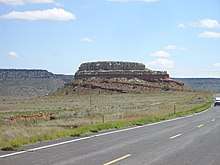Dockum Group
The Dockum is a Late Triassic (approximately late Carnian through Rhaetian, or 223–200 Ma) geologic group found primarily on the Llano Estacado of western Texas and eastern New Mexico with minor exposures in southwestern Kansas, eastern Colorado, and Oklahoma panhandle.[1] The Dockum reaches a maximum thickness of slightly over 650 m but is usually much thinner. The Dockum rests on an unconformity over the Anisian (242–234 Ma) aged Anton Chico Formation. The Dockum and Chinle Formation were deposited roughly at the same time and share many of the same vertebrates and plant fossils. They appear to have very similar paleoenviroments.[2] The two units are approximately separated by the Rio Grande in central New Mexico. The Chinle and Dockum are thought by some to be two separate units, deposited in separate depositional basins.
| Dockum Group Stratigraphic range: late Carnian-Rhaetian ~223–200 Ma | |
|---|---|
 Steamboat Butte, showing Dockum Group red beds at its base | |
| Type | Group |
| Sub-units | See text |
| Underlies | Exeter Sandstone |
| Overlies | Anton Chico Formation |
| Lithology | |
| Primary | Sandstone |
| Other | Siltstone, Mudstone |
| Location | |
| Coordinates | 35.356°N 102.910°W |
| Country | |
| Type section | |
| Named for | Town of Dockum, Texas |
| Named by | William Fletcher Cummins |
| Year defined | 1890 |
History of investigation
There is no designated type locality for this formation. The Dockum was named by William Fletcher Cummins for a good exposure in vicinity of town of Dockum in Dickens County, Texas, in 1890.[3] Lucas included the Dockum Group within the Chinle when he raised the Chinle to group status.[4] Most researchers still maintain the Chinle is a formation and separate from the Dockum Group. Dockum was named before the Chinle, and if Lucas is correct, his "Chinle Group" should be named the Dockum Group due to stratigraphic nomenclature rules.
Stratigraphy
Lehman (1994) advocated a simplified stratigraphy of up to five geologic formations.[5] The basal unit is the Santa Rosa Sandstone, a braided stream channel-related facies. The Santa Rosa is overlain by the Tecovas Formation, which is dominated by overbank (distal floodplain) deposits with lenses of channel-deposits. Minor lacustrine deposits are also occurring. The Trujillo Sandstone, channel-deposits, and Cooper Canyon Formation, overbank deposits with minor channel and lacustrine deposits, are separated from the Santa Rosa-Tecovas by an unconformity. In eastern New Mexico, the Redonda Formation overlies the Cooper Canyon Formation. The Redonda has gradational eastward transition into the upper Cooper Canyon Formation.
The Santa Rosa-Tecovas sequence has sediments made up of clasts derived from the north, northeast, and east of the Dockum, very similar to clasts found in the lower Chinle. However, the Trujillo-Cooper Canyon sequence's sediments are derived from the Ouachita orogenic belts of the Marathon Uplift.
Dockum and Chinle correlation
Correlations and ages based on Spencer G. Lucas' Land Vertebrate Faunachrons.[6] The faunachrons are based on first and last appearances of phytosaurs.[7] Simplified Chinle stratigraphy based on Litwin.[8]
| Sub-stage | Faunachron | Chinle | Dockum |
|---|---|---|---|
| late Norian-Rhaetian | Apachean | Rock Point/Church Rock | Redonda |
| early to middle Norian | Revueltian | Owl Rock, Upper Petrified Forest | Cooper Canyon |
| upper late Carnian | Adamanian | Upper Petrified Forest, Moss Back, Monitor Butte | Trujillo, Tecovas |
| lower late Carnian | Otischalkian | Shinarump, Temple Mountain | Santa Rosa |
See also
- List of dinosaur-bearing rock formations
References
- Dunaway, R.E., and Fisher, M.J., 1979. Palynology of the Dockum Group (Upper Triassic), Texas, U.S.A. Review of Paleobotany and Palynology, v. 28, p. 61–92.
- Cornet, B., 1993. Applications and limitations of palynology in age, climatic, and paleoenviromental analyses of Triassic sequences in North America. New Mexico Museum of Natural History Bulletin 3:75–93.
- Cummins, W.F. 1892. Report on the geography, topography, and geology of the Llano Estacado or Staked Plains with notes on the geology of the country west of the Plains. In: Dumble, E.T. (ed), Third annual report of the Geological Survey of Texas 1891. Austin: Henry Hutchings, State Printer.
- Lucas, S.G., 1993. The Chinle Group: revised stratigraphy and biochronology of Upper Triassic Nonmarine strata in the western United States. Museum of Northern Arizona Bulletin, v. 59, p. 27–50.
- Lehman, T. M. 1994. The saga of the Dockum Group and the case of the Texas/New Mexico boundary fault. New Mexico Bureau of Mines & Mineral Resources Bulletin, v. 150, p. 37-51.
- Lucas, S.G., 1998. Global Triassic tetrapod biostratigraphy and biochronology. Palaeogeography, Palaeoclimatology, and Palaeoecology, v. 143, p. 347–384.
- Lehman, T.M., and Chatterjee, S., 2005. Depositional setting and vertebrate biostratigraphy of the Triassic Dockum Group of Texas. Journal of Earth System Science, v. 114, p. 325-351.
- Litwin, R.J., Traverse, A., and Ash, S.R., 1991. Preliminary palynological zonation of the Chinle Formation, southwestern U.S.A., and its correlation to the Newark Supergroup (eastern U.S.A.). Review of Paleobotany and Palynology, v. 77, p. 269–287.